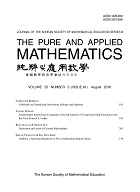 ISSN : 1226-0657
ISSN : 1226-0657
Article Contents
- 2024 (Vol.31)
- 2023 (Vol.30)
- 2022 (Vol.29)
- 2021 (Vol.28)
- 2020 (Vol.27)
- 2019 (Vol.26)
- 2018 (Vol.25)
- 2017 (Vol.24)
- 2016 (Vol.23)
- 2015 (Vol.22)
- 2014 (Vol.21)
- 2013 (Vol.20)
- 2012 (Vol.19)
- 2011 (Vol.18)
- 2010 (Vol.17)
- 2009 (Vol.16)
- 2008 (Vol.15)
- 2007 (Vol.14)
- 2006 (Vol.13)
- 2005 (Vol.12)
- 2004 (Vol.11)
- 2003 (Vol.10)
- 2002 (Vol.9)
- 2001 (Vol.8)
- 2000 (Vol.7)
- 1999 (Vol.6)
- 1998 (Vol.5)
- 1997 (Vol.4)
- 1996 (Vol.3)
- 1995 (Vol.2)
- 1994 (Vol.1)
POSITIVE SOLUTION FOR SYSTEMS OF NONLINEAR SINGULAR BOUNDARY VALUE PROBLEMS ON TIME SCALES
Ji, Dehong
Zhao, Junfang
Ge, Weigao
Zhang, Jiani
Abstract
In this paper, we deal with the following system of nonlinear singular boundary value problems(BVPs) on time scale <TEX>$\mathbb{T}$</TEX> <TEX>$$\{{{{{{x^{\bigtriangleup\bigtriangleup}(t)+f(t,\;y(t))=0,\;t{\in}(a,\;b)_{\mathbb{T}},}\atop{y^{\bigtriangleup\bigtriangleup}(t)+g(t,\;x(t))=0,\;t{\in}(a,\;b)_{\mathbb{T}},}}\atop{\alpha_1x(a)-\beta_1x^{\bigtriangleup}(a)=\gamma_1x(\sigma(b))+\delta_1x^{\bigtriangleup}(\sigma(b))=0,}}\atop{\alpha_2y(a)-\beta_2y^{\bigtriangleup}(a)=\gamma_2y(\sigma(b))+\delta_2y^{\bigtriangleup}(\sigma(b))=0,}}$$</TEX> where <TEX>$\alpha_i$</TEX>, <TEX>$\beta_i$</TEX>, <TEX>$\gamma_i\;{\geq}\;0$</TEX> and <TEX>$\rho_i=\alpha_i\gamma_i(\sigma(b)-a)+\alpha_i\delta_i+\gamma_i\beta_i$</TEX> > 0(i = 1, 2), f(t, y) may be singular at t = a, y = 0, and g(t, x) may be singular at t = a. The arguments are based upon a fixed-point theorem for mappings that are decreasing with respect to a cone. We also obtain the analogous existence results for the related nonlinear systems <TEX>$x^{\bigtriangledown\bigtriangledown}(t)$</TEX> + f(t, y(t)) = 0, <TEX>$y^{\bigtriangledown\bigtriangledown}(t)$</TEX> + g(t, x(t)) = 0, <TEX>$x^{\bigtriangleup\bigtriangledown}(t)$</TEX> + f(t, y(t)) = 0, <TEX>$y^{\bigtriangleup\bigtriangledown}(t)$</TEX> + g(t, x(t)) = 0, and <TEX>$x^{\bigtriangledown\bigtriangleup}(t)$</TEX> + f(t, y(t)) = 0, <TEX>$y^{\bigtriangledown\bigtriangleup}(t)$</TEX> + g(t, x(t)) = 0 satisfying similar boundary conditions.
- keywords
- singular boundary value problem, nonlinear system, time scale, fixed point theorem
Reference
(2001). . J. Differential Equations, 175, 393-414.
(2007). . Nonlinear Anal., 67, 368-381.
(1989). . J. Differential Equations, 79, 62-78.
(2005). . J. Differential Equations, 211, 282-302.
(2004). . Comput. Appl. Math., 47, 683-688.
(1976). . SIAM Rev., 18, 620-709.
(1999). . J. Math. Anal. Appl., 240, 433-445.
(2007). . J. Math. Anal. Appl., 325, 517-528.
(2009). . J. Comput. Appl. Math., 223(1), 291-303.
(1990). . Ann. Mat. Pura Appl., 157, 1-25.
(2004). . J. Math. Anal. Appl, 290, 35-54.
(1997). . Nonlinear Anal., 28, 1429-1438.
(2007). . Rocky Mountain J. Math., 137(4), 1229-1250.
(2007). . J. Differential Equations, 239, 196-212.
(2004). . J. Math. Anal. Appl., 295, 378-391.
(2008). . Nonlinear Anal., 69, 2833-2842.
(1998). . J. Differential Equations, 143, 60-95.
(2008). . Appl. Math. Comput., 200(1), 352-368.
(1990). . Mathematical Research, 59, 9-20.
(2006). . J. Comput. Appl. Math., 197, 156-168.
(1990). . Result. Math., 18, 18-56.
(1998). . J. Differential Equations, 148, 407-421.
(2006). . J. Math. Anal. Appl., 324, 118-133.
- Downloaded
- Viewed
- 0KCI Citations
- 0WOS Citations
